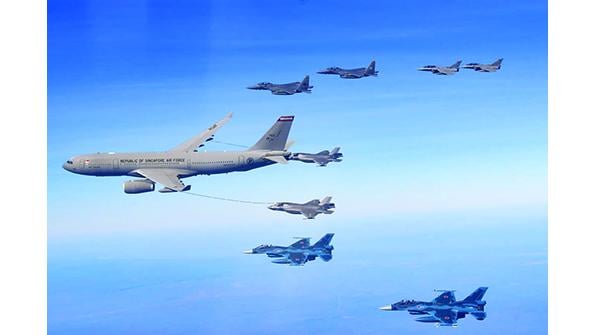
Over a period of one week, more than 10 air forces descended upon the north Australian city of Darwin for the Southern Hemisphere’s largest aerial exercise, Pitch Black. Because of COVID-19, the last such event was in 2018, and much has changed over the last four years.
- Platform is enabling nations to operate with allies
- European countries are finally able to project power into the Indo-Pacific
In that time, the Taliban reclaimed Afghanistan, Russia invaded Ukraine, and China fired missiles over Taiwan. In light of these security concerns, countries including Germany, Japan and South Korea are joining multilateral exercises in the Asia Pacific region to test their ability to project power and operate alongside allied nations.
A key enabler of military missions over far-flung countries at this exercise was the Airbus A330 Multi-Role Tanker Transport (MRTT). Australia, France, Germany, Singapore, South Korea and the UK brought the MRTT to the exercise, many for the first time since it had been delivered.
France and Germany had deployed ships in the region in the last few years, but the MRTT allowed them to bring aircraft as well. The German Air Force’s Rapid Pacific exercise aimed to send six Eurofighter Typhoons to Singapore within 24 hr. Three MRTTs from the Multinational MRTT Fleet (MMF) deployed from Eindhoven enabled the Germans to reach their time target, even though the flagship Eurofighter was stuck in Abu Dhabi due to technical issues.
The MMF fleet technically only required two MRTTs for the six fighters but threw in a spare tanker, as initial calculations expected fuel status to be “tight.” The backup was not used during the Abu Dhabi-Singapore flight.
German Air Force Lt. Col. Marcel Nowak, MMF detachment commander, said the two-year-old unit is taking small steps during this deployment to reach initial operational capability. It will aim to achieve certification with Australia’s Lockheed Martin F-35As and Boeing Super Hornets. Only the German Typhoons are allowed to tank with the MMF MRTT at this time.
France, with two MRTTs, brought three Dassault Rafale and two Airbus A400M aircraft to its Pacific territory of New Caledonia in 72 hr., in a region that has been a focus since China reached a security pact with the Solomon Islands this year. The French aircraft reached Darwin in 32 hr., and New Caledonia within the allotted 72 hr.
French Air and Space Force (FASF) Maj. Gen. Stephane Groen, air chief of staff of the air defense and air operations command, says the MRTT has allowed the FASF to become more global. The detachment used the MRTT satellite communications capability to get real-time clearance from headquarters in France to “fire” its Scalp missiles against a simulated target in New Caledonia in an exercise, Groen says. He did not discount the possibility of conducting a similar deployment with other European MRTT operators under the EU flag.
Enhanced tanking capabilities have given these air forces the ability to deploy to an area of potential conflict with minimal hops, either due to lack of diplomatic access or the unavailability of an airfield.
MRTTs at the Pitch Black exercise allowed for asset sharing among nations: A Royal Air Force Voyager tanked a U.S. Marine Corps F-35B, while a French one passed fuel to Indian Sukhoi Su-30s and Australian Boeing EA-18G Growlers.
Although recently accepting delivery of its new air-to-air refueling (A3R) MRTT, Singapore brought its non-A3R aircraft to the exercise to focus on integration with F-35s. The Republic of Singapore Air Force (RSAF) used its boom and underwing pods to refuel Australian F-35s and U.S. F-35Bs.
RSAF air refueling operator 2nd Sgt. Lim Li Jun says 112 Sqdn. started simulating F-35 tanking training during the lead up to Pitch Black. She says the F-35 is easier to refuel from the boom, as it is “bulkier” and more stable when coming in for the boom.
Marine Corps F-35B pilot Capt. Anneliese Satz says the process was “smooth, with good contact and fuel flow.”
An RSAF MRTT pilot, Maj. Michelle Teo, says the Pitch Black “tanker cell” would assign the receivers during the missions based on a compatibility matrix and certification. Singapore took on more tanking duties due to its larger pools of approved receivers and also flew both day and night waves. The RSAF also carried out tanker-to-tanker refueling with Australian MRTTs, known locally as KC-30s.
Operators say interoperability with receiver types is transparent since aircraft types are similar. In fact, paperwork presents a greater hurdle to multinational cross-tanking, they say.


Comments